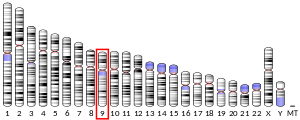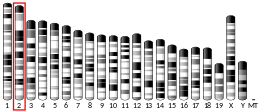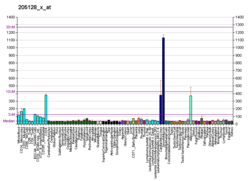シクロオキシゲナーゼ1
シクロオキシゲナーゼ1(英: cyclooxygenase-1、略称: COX-1)またはプロスタグランジンエンドペルオキシドシンターゼ1(英: prostaglandin-endoperoxide synthase 1、略称: PTGS1)は、ヒトではPTGS1遺伝子によってコードされている酵素である[5][6]。
歴史
[編集]シクロオキシゲナーゼ(COX)は、アラキドン酸からプロスタグランジンを生合成する経路の中心的酵素である。COX-1は40年以上前に単離され、1988年にクローニングされた[7][8]。
遺伝子とアイソザイム
[編集]COXには、構成型のCOX-1と誘導型のCOX-2という2種類のアイソザイムが存在する。それぞれ異なる遺伝子にコードされており、関連するサイトカインや成長因子によって異なる調節を受けているため、発現調節や組織分布は異なっている。COX-1はPTGS1遺伝子によってコードされており、内皮細胞において血管新生を調節していることが知られている[9]。イヌの中枢神経系ではCOX-3と呼ばれるCOX-1のスプライスバリアントが同定されているが、ヒトでは同様の機構で機能的タンパク質が形成されることはない。また、COX-1由来の小さなタンパク質(PCOX-1a、PCOX-1b)も発見されている。これらの正確な役割の記載はまだなされていない[10]。
機能
[編集]プロスタグランジンエンドペルオキシドシンターゼ(PTGS)またはシクロオキシゲナーゼ(COX)は、プロスタグランジン生合成において重要な酵素であり、ホスホリパーゼA2による膜リン脂質のsn-2位のエステル結合の切断によって生じた遊離アラキドン酸をプロスタグランジンH2(PGH2)へ変換する。この酵素反応は、シクロオキシゲナーゼ(ジオキシゲナーゼ)活性とヒドロペルオキシダーゼ(ペルオキシダーゼ)活性の双方を伴う。シクロオキシゲナーゼ活性によってアラキドン酸(もしくはリノレン酸、エイコサペンタエン酸などの多価不飽和脂肪酸)へ2つの酸素分子が組み込まれる。アラキドン酸の代謝では不安定な中間体ペルオキシドであるプロスタグランジンG2(PGG2)が形成され、その後ヒドロペルオキシダーゼ活性によって対応するアルコールであるPGH2へと還元される。
COX-1はアラキドン酸を主にPGG2へ代謝するが、少量は15-ヒドロキシエイコサテトラエン酸(15-HETE)のラセミ混合物(~22% 15(R)-HETE、~78% 15(S)-HETE)や11(R)-HETEも変換される[11]。2種類の15-HETE立体異性体は固有の生物学的活性を有するが、おそらくそれよりも重要なのは、さらに主要な抗炎症因子であるリポキシンへと代謝されることである[12]。加えて、PGG2とPGH2は非酵素的に12-ヒドロキシヘプタデカトリエン酸(12-HHT)の混合物(すなわち12-(S)-ヒドロキシ-5Z,8E,10E-ヘプタデカトリエン酸と12-(S)-ヒドロキシ-5Z,8Z,10E-ヘプタデカトリエン酸)とマロンジアルデヒドへ変換される[13][14][15]。またCYP2S1によって12-HHTへ代謝される場合もある[16][17]。こうしたCOX-1による代替的代謝産物がその生理活性に寄与している可能性もある。
胃の内部を保護し、胃酸の分泌やペプシン含有量の低下に寄与している粘液層の形成をCOX-1は促進する[18][19]。通常、COX-1は胃だけではなく、炎症部位を含む体内のさまざまな部位に存在している。
臨床的意義
[編集]COX-1はアスピリンなどの非ステロイド性抗炎症薬(NSAIDs)によって阻害される。血小板におけるCOX-1の主要産物であるトロンボキサンA2は、血小板の凝集を誘導する[20][21]。低用量アスピリンの心イベント低減の有効性はCOX-1阻害によって説明される。
出典
[編集]- ^ a b c GRCh38: Ensembl release 89: ENSG00000095303 - Ensembl, May 2017
- ^ a b c GRCm38: Ensembl release 89: ENSMUSG00000047250 - Ensembl, May 2017
- ^ Human PubMed Reference:
- ^ Mouse PubMed Reference:
- ^ “Cloning of human gene encoding prostaglandin endoperoxide synthase and primary structure of the enzyme”. Biochemical and Biophysical Research Communications 165 (2): 888–94. (December 1989). doi:10.1016/S0006-291X(89)80049-X. PMID 2512924.
- ^ “Human platelet/erythroleukemia cell prostaglandin G/H synthase: cDNA cloning, expression, and gene chromosomal assignment”. FASEB Journal 5 (9): 2304–12. (June 1991). doi:10.1096/fasebj.5.9.1907252. PMID 1907252.
- ^ “Structure of COX-1 and COX-2 enzymes and their interaction with inhibitors”. Drugs of Today 35 (4–5): 237–50. (1999). doi:10.1358/dot.1999.35.4-5.552200. PMID 12973429.
- ^ “Roles of COX-1 and COX-2 in gastrointestinal pathophysiology”. Journal of Gastroenterology 33 (5): 618–24. (October 1998). doi:10.1007/s005350050147. PMID 9773924.
- ^ “Entrez Gene: PTGS1 prostaglandin-endoperoxide synthase 1 (prostaglandin G/H synthase and cyclooxygenase)”. 2025年2月20日閲覧。
- ^ “COX-3, a cyclooxygenase-1 variant inhibited by acetaminophen and other analgesic/antipyretic drugs: cloning, structure, and expression”. Proceedings of the National Academy of Sciences of the United States of America 99 (21): 13926–31. (October 2002). doi:10.1073/pnas.162468699. PMC 129799. PMID 12242329.
- ^ “Identification and absolute configuration of dihydroxy-arachidonic acids formed by oxygenation of 5S-HETE by native and aspirin-acetylated COX-2”. Journal of Lipid Research 51 (3): 575–85. (March 2010). doi:10.1194/jlr.M001719. PMC 2817587. PMID 19752399.
- ^ “Lipoxins and aspirin-triggered 15-epi-lipoxins are the first lipid mediators of endogenous anti-inflammation and resolution”. Prostaglandins, Leukotrienes, and Essential Fatty Acids 73 (3–4): 141–62. (2005). doi:10.1016/j.plefa.2005.05.002. PMID 16005201.
- ^ “On the organization and mechanism of prostaglandin synthetase”. The Journal of Biological Chemistry 248 (16): 5673–8. (August 1973). doi:10.1016/S0021-9258(19)43558-8. PMID 4723909.
- ^ “Prostaglandin endoperoxides. Novel transformations of arachidonic acid in human platelets”. Proceedings of the National Academy of Sciences of the United States of America 71 (9): 3400–4. (September 1974). Bibcode: 1974PNAS...71.3400H. doi:10.1073/pnas.71.9.3400. PMC 433780. PMID 4215079.
- ^ “Development and review of radioimmunoassay of 12-S-hydroxyheptadecatrienoic acid”. Prostaglandins & Other Lipid Mediators 56 (2–3): 53–76. (June 1998). doi:10.1016/s0090-6980(98)00043-4. PMID 9785378.
- ^ “Human CYP2S1 metabolizes cyclooxygenase- and lipoxygenase-derived eicosanoids”. Drug Metabolism and Disposition 39 (2): 180–90. (February 2011). doi:10.1124/dmd.110.035121. PMC 3033693. PMID 21068195.
- ^ “Cytochrome P4502S1: a novel monocyte/macrophage fatty acid epoxygenase in human atherosclerotic plaques”. Basic Research in Cardiology 108 (1): 319. (January 2013). doi:10.1007/s00395-012-0319-8. PMID 23224081.
- ^ “Gastric mucosal defense and cytoprotection: bench to bedside”. Gastroenterology 135 (1): 41–60. (2008). doi:10.1053/j.gastro.2008.05.030. PMID 18549814.
- ^ Harrison's Principles of Internal Medicine (17th ed.). New York: McGraw-Hill Medical. (2008). p. 661. ISBN 978-0-07-146633-2
- ^ Parker, Keith L.; Brunton, Laurence L.; Lazo, John S. (2005). Goodman & Gilman's The Pharmacological Basis of Therapeutics (11th ed.). New York: McGraw-Hill Medical Publishing Division. p. 1126. ISBN 0-07-142280-3
- ^ Weitz, Jeffrey I (2008). “Chapter 112. Antiplatelet, Anticoagulant, and Fibrinolytic Drugs”. Harrison's Principles of Internal Medicine (17th ed.). New York: McGraw-Hill Medical. ISBN 978-0-07-146633-2
関連文献
[編集]- “Signaling pathways regulating aromatase and cyclooxygenases in normal and malignant breast cells”. The Journal of Steroid Biochemistry and Molecular Biology 80 (2): 203–12. (February 2002). doi:10.1016/S0960-0760(01)00187-X. PMID 11897504.
- “Expression and cellular localization of cyclooxygenases and prostaglandin E synthases in the hemorrhagic brain”. Journal of Neuroinflammation 8: 22. (2011). doi:10.1186/1742-2094-8-22. PMC 3062590. PMID 21385433.
- “Prevention of head and neck cancer: current status and future prospects”. Current Problems in Cancer 28 (5): 265–86. (2004). doi:10.1016/j.currproblcancer.2004.05.003. PMID 15375804.
- “The role of the cylooxygenase pathway in nociception and pain”. Seminars in Cell & Developmental Biology 17 (5): 544–54. (October 2006). doi:10.1016/j.semcdb.2006.09.001. PMID 17071117.
- “Alternative splicing of human prostaglandin G/H synthase mRNA and evidence of differential regulation of the resulting transcripts by transforming growth factor beta 1, interleukin 1 beta, and tumor necrosis factor alpha”. The Journal of Biological Chemistry 267 (15): 10816–22. (May 1992). doi:10.1016/S0021-9258(19)50092-8. PMID 1587858.
- “Immunoaffinity purification and cDNA cloning of human platelet prostaglandin endoperoxide synthase (cyclooxygenase)”. Biochemical and Biophysical Research Communications 182 (2): 433–8. (January 1992). doi:10.1016/0006-291X(92)91750-K. PMID 1734857.
- “Inducible isoforms of cyclooxygenase and nitric-oxide synthase in inflammation”. Proceedings of the National Academy of Sciences of the United States of America 91 (6): 2046–50. (March 1994). Bibcode: 1994PNAS...91.2046V. doi:10.1073/pnas.91.6.2046. PMC 43306. PMID 7510883.
- “HIV coating gp 120 glycoprotein-dependent prostaglandin E2 release by human cultured astrocytoma cells is regulated by nitric oxide formation”. Biochemical and Biophysical Research Communications 203 (1): 87–92. (August 1994). doi:10.1006/bbrc.1994.2152. PMID 7521167.
- “Transcriptional regulation of human prostaglandin-endoperoxide synthase-2 gene by lipopolysaccharide and phorbol ester in vascular endothelial cells. Involvement of both nuclear factor for interleukin-6 expression site and cAMP response element”. The Journal of Biological Chemistry 270 (42): 24965–71. (October 1995). doi:10.1074/jbc.270.42.24965. PMID 7559624.
- “Prostaglandin H synthase-1: evaluation of C-terminus function”. Archives of Biochemistry and Biophysics 316 (2): 751–7. (February 1995). doi:10.1006/abbi.1995.1100. PMID 7864630.
- “The X-ray crystal structure of the membrane protein prostaglandin H2 synthase-1”. Nature 367 (6460): 243–9. (January 1994). Bibcode: 1994Natur.367..243P. doi:10.1038/367243a0. PMID 8121489.
- “Characterization of the human gene (PTGS2) encoding prostaglandin-endoperoxide synthase 2”. European Journal of Biochemistry 221 (3): 889–97. (May 1994). doi:10.1111/j.1432-1033.1994.tb18804.x. PMID 8181472.
- “N-glycosylation of prostaglandin endoperoxide synthases-1 and -2 and their orientations in the endoplasmic reticulum”. The Journal of Biological Chemistry 268 (24): 18234–42. (August 1993). doi:10.1016/S0021-9258(17)46835-9. PMID 8349699.
- “Expression of mRNA for cyclooxygenase-1 and cyclooxygenase-2 in human tissues”. FEBS Letters 330 (2): 156–60. (September 1993). doi:10.1016/0014-5793(93)80263-T. PMID 8365485.
- “Death of cultured human neuroblastoma cells induced by HIV-1 gp120 is prevented by NMDA receptor antagonists and inhibitors of nitric oxide and cyclooxygenase”. Neurodegeneration 4 (3): 315–21. (September 1995). doi:10.1016/1055-8330(95)90021-7. PMID 8581564.
- “Interaction of cyclooxygenases with an apoptosis- and autoimmunity-associated protein”. Proceedings of the National Academy of Sciences of the United States of America 93 (11): 5544–9. (May 1996). Bibcode: 1996PNAS...93.5544B. doi:10.1073/pnas.93.11.5544. PMC 39283. PMID 8643612.
- “Molecular characterization of the 5.2 KB isoform of the human cyclooxygenase-1 transcript”. Prostaglandins 51 (1): 81–5. (January 1996). doi:10.1016/0090-6980(95)00158-1. PMID 8900446.
- “Adult human colonic subepithelial myofibroblasts express extracellular matrix proteins and cyclooxygenase-1 and -2”. The American Journal of Physiology 273 (6 Pt 1): G1341-8. (December 1997). doi:10.1152/ajpgi.1997.273.6.G1341. PMID 9435560.
- “Cyclooxygenase regulates angiogenesis induced by colon cancer cells”. Cell 93 (5): 705–16. (May 1998). doi:10.1016/S0092-8674(00)81433-6. PMID 9630216.








